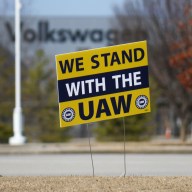The new bike lanes continue to be a contentious issue, what are your thoughts?
They’ve been contentious, but so far they’ve been successful. With Hornby Street, we complete the network from Kitsilano to Chinatown, across Burrard, down Hornby and then out the Dunsmuir Viaduct. The bike lanes will also connect the seawalls through downtown.
People have increasingly been using transit, bikes and walking, so we have to keep improving the facilities to make sure we’re keeping up with that demand.
So you see it as a bit of an experiment?
Yeah, big cities around the world are doing this too: Paris, London, New York.
I think more people would like to ride a bike, but want to be safe. And we’ve been pushing really hard for more transit in Vancouver — more buses, rapid transit — and we’re waiting for the investment from the B.C. and federal governments, but in the meantime we can improve cycling and walking in the city.
Is it in the best interest of businesses on Hornby Street, and will it cause traffic problems to worsen?
We’ve looked at research in other cities that have put bike lanes in, and the lanes are a positive impact on business everywhere else, and we expect that will be the case in Vancouver. But it means some change to the traffic patterns.
Part of your platform included improvements to transit within Vancouver, what has been done?
It’s at an impasse right now. The funding model is maxed and we need a lot more transit. The fares have been maxed out as well, and we don’t support raising the fares. We need to see something like the carbon tax used to provide more buses and rapid transit.
One of your ambitions is to make Vancouver the greenest city in the world by 2020. What would you say to people who have to drive between cities for their business?
Electric vehicles are a big priority for us, and making sure we have charging infrastructure. We expect 15 per cent of vehicles to be electric by 2020, and that’s what we’re preparing for.
We’re lucky that we have hydroelectric power here, so it is a dramatic reduction in carbon emissions. And B.C. Hydro is working on increasing capacity to support electric vehicles in the future.
How soon do you think we might see the Olympic Village loan recouped?
Well it will take a couple years to sell through the units, and we won’t really know the end result until 2012 at the earliest.
There are roughly 1,800 people either living on the street or in homeless shelters around the city. How do you plan to address that?
Well, we’ve made huge strides the last two years. We’ve reduced the street homeless count by 42 per cent, so about 450 people have moved from the street into the shelters. We’ve got a partnership with B.C. Housing that will open 1,500 units of social housing over the next couple of years. That’ll help significantly to get people off the street and out of shelters.
















